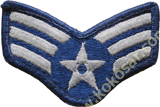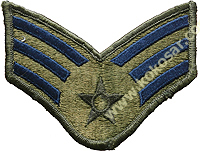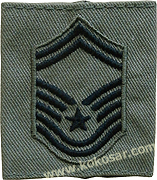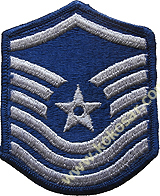|
AIRMAN BASIC
(E-1)
ZRAKOPLOVAC REGRUT |
| |
|
Avijatičar regrut je najniži u hijerarhiji Avijacije SAD-a. Njegovi su
zadaci obuka u vojnoj disciplini i vojnim vještinama potrebnim u
avijaciji. Kako regruti ne nose oznake čina, dobili su nadimak „glatki
rukav“ (slick-sleeves). Uobičajeno je da prvo promaknuće slijedi nakon
šest mjeseci te nakon uspješno provedene obuke (pod uvjetom da nisu
kršili disciplinu). |
|
Airman Basic (AB) is the lowest enlisted rank of the US Air Force. The
responsibilities of an Airman Basic include learning about and
displaying knowledge of Air Force customs and standards, as well as
learning the military and technical skills required in the Air Force.
One identifying marker of an airman basic's uniform is that they have no
rank insignia. They are nicknamed “slick-sleeves,” because, while all
other ranks have rank insignias on their sleeves, the airman basic's
sleeves are plain. Airman basics are typically promoted to airman after
just six months in grade. Assuming the airman basic has maintained
standards and not committed any striking offenses, the promotion is
guaranteed. |
| |
|
|
|
AIRMAN
(E-2)
ZRAKOPLOVAC |
| |
|
Čin
zrakoplovca sa sobom nosi odgovornost prilagođavanja vojnom načinu
života u zračnim snagama i osposobljavanje za zanimanje zračnih snaga.
Po završetku osnovne obuke, svi zrakoplovci ulaze u obuku u škole ratnog
zrakoplovstva za svoje specijalnosti („poslove“), ovisno o njihovim
sklonostima i interesima te potrebama ratnog zrakoplovstva. |
|
|
|
|
 |
 |
 |
| |
|
1976–1991 |
| |
|
|
|
The rank of airman brings with it the responsibility of adjusting to the
Air Force way of military life and becoming proficient in an Air Force
occupational specialty. Upon leaving basic training, all airmen enter
training at Air Force schools in their specialties ("jobs"), depending
on their aptitudes and interests, and the needs of the Air Force. |
|
|
|
|
|
AIRMAN FIRST CLASS
(E-3)
ZRAKOPLOVAC PRVE KLASE |
| |
|
Smatra se da su zrakoplovci prve klase potpuno prilagođeni zračnim
snagama i vojnom životu, a njihove dužnosti su usmjerene na učinkovito i
djelotvorno izvršavanje zadataka uz brušenje radnih vještina.
Avijatičarima prve klase dodjeljuje se sve veća odgovornost. Od
zrakoplovca prve klase se očekuje da bude u skladu sa standardima
zračnih snaga i služi kao uzor podređenima. Osim toga, od njih se
očekuje da počnu svladavati svoj posao i vještine vođenja. |
|
Promicanje (unapređenje) u viši čin zrakoplovnih snaga: Zračne snage
zahtijevaju od zrakoplovaca regruta (E-2) da imaju najmanje 10 mjeseci u
službi prije nego što mogu biti promaknuti u zrakoplovce prve klase. Ne
postoje zahtjevi za vrijeme u službi (TIS) za zrakoplovce prve klase.
Uloga i odgovornosti zrakoplovaca prve klase rastu kako se njihovo
iskustvo povećava i oni postaju kalfe i vođe. Prosječno vrijeme aktivne
službe u Zračnim snagama za unapređenje u čin zrakoplovca prve klase je
16 mjeseci. |
|
|
|
|
 |
 |
 |
|
1976–1991 |
|
|
|
|
|
|
|
Airmen first class are considered to be fully adjusted to Air Force and
military life, and their duties focus on carrying out their assignments
efficiently and effectively while honing their job skills. Airmen first
class are assigned an increasing level of responsibility. An Airman
first class is expected to comply with Air Force standards and serve as
a role model for subordinates. In addition, they are expected to start
mastering their job and leadership skills. |
|
Moving up the Air Force Ranks:
The Air Force requires airmen basic ( E-2) to have at least 10 months'
time in grade before they can be promoted to airman first class. There
are no time in service (TIS) requirements for airman first class. An
airman first class' role and responsibilities increase as their
experience increases and they become journeymen and leaders. The average
Air Force-wide, active-duty time for promotion to the rank of airman
first class is 16 months. |
|
|
|
|
|
SENIOR AIRMAN
(E-4)
STARIJI ZRAKOPLOVAC |
| |
|
Čin
višeg zrakoplovca je prijelazno razdoblje od kalfe u podoficira
(dočasnika) (NCO). Bitno je da zrakoplovci razviju vještine nadzora i
vođenja kroz profesionalno vojno iskustvo (PME) i individualno učenje.
Od njih se očekuje da se ponašaju u skladu s utvrđenim standardima,
pružajući pozitivan utjecaj i primjer svojim podređenima i kolegama.
Stariji zrakoplovci predstavljaju sliku kompetencije, integriteta i
ponosa. |
|
Napredovanje u činovima zrakoplovnih snaga: Zračne snage zahtijevaju da
zrakoplovac prve klase ima 28 mjeseci u razredu (TIG), ili 36 mjeseci
TIS-a i 20 mjeseci TIG-a. Prosječno vrijeme aktivne službe za
napredovanje u čin starijeg zrakoplovca je tri godine. |
|
Iznimka od pravila: stariji zrakoplovac (E-4) ispod zone -- Zapovjednici
jedinica zračnih snaga ovlašteni su u šest mjeseci unaprijediti 15%
svojih uzornih zrakoplovaca prve klase (E-3) u starije zrakoplovce (E-4)
ispred normalnog TIS-a. Odluka zapovjednika postrojbe prvenstveno se
temelji na promotivnom rosteru. Velike jedinice provode promotivne
rostere "u kući" i odabiru do 15% za ranu promociju. Male jedinice
spajaju kandidate u "bazen" i tvore središnji bazni odbor (CBB). |
|
|
|
|
 |
 |
 |
|
|
1976–1991 |
|
 |
 |
 |
|
|
|
|
 |
|
|
|
|
|
|
|
The rank of senior airman is a transition period from journeyman to
non-commissioned officer (NCO). It is essential that airmen develop
supervisory and leadership skills through professional military
experience (PME) and individual study. They are expected to conduct
themselves in accordance with established standards, providing a
positive influence and example for their subordinates and peers alike.
Senior airmen present the image of competence, integrity and pride. |
|
Moving up the Air Force Ranks: The Air Force requires for
airman first class to have 28 months' time in grade (TIG), or 36 months
of TIS and 20 months of TIG. The average servicewide, active-duty time
for advancement to the rank of senior airman is three years. |
|
Exception to the Rule: Senior Airman (E-4)
Below-the-Zone -- Air Force unit commanders are authorized to promote
15% of their exemplary airmen first class (E-3) to senior airmen (E-4)
six months ahead of the normal TIS. The unit commander's decision is
based primarily on a promotion board. Large units conduct the promotion
boards "in-house" and select up to 15% for early promotion. Small units
combine applicants into a pool and form a Central Base Board (CBB). |
|
|
|
|
|
NON-COMMISSIONED
OFFICERS (NCO) (E-5 and E-6)
PODOFICIRI |
| |
|
Pripadnici avijacije u rangu E-5 i E-6 nazivaju se podoficiri
(dočasnici). Od podoficira zračnih snaga se očekuje da budu primjer
osobnog integriteta, odanosti, vodstva, predanosti i odanosti dužnosti,
uključujući poštivanje politike, tradicije i standarda Zračnih
snaga.Podoficiri zračnih snaga i viši podoficiri promaknuti su na
temelju Weighted Airman Promotion System (WAPS). Zrakoplovci s
odgovarajućom razinom TIS/TIG/vještine i preporukom zapovjednika natječu
se za promaknuće na temelju svojih "WAPS bodova" unutar svog AFSC-a (Air
Force Specialty Code). WAPS bodovi za promociju izvode se iz sustava
koji daje bodove za ispite za promociju fitnessa (PFE), test znanja o
specijalnosti (SKT), medalje i nagrade, vrijeme u rangu (TIG)/vrijeme u
službi (TIS) i ocjenjivanje službe. |
| |
|
|
|
Air Force enlisted members E-5 and E-6 are referred to as NCOs. Air
Force NCOs are expected to exemplify personal integrity, loyalty,
leadership, dedication and devotion to duty, including upholding Air
Force policies, traditions and standards. Air Force NCOs and Senior
NCOs are promoted based on the Weighted Airman Promotion System (WAPS).
Airmen with the proper TIS/TIG/skill level and commander's
recommendation compete for promotion based on their "WAPS Points" within
their AFSC (Air Force Specialty Code). The WAPS promotion points are
derived from a system that gives points for the promotion fitness
examination (PFE), specialty knowledge test (SKT), medals and awards,
time in grade (TIG)/time in service (TIS) and performance evaluations. |
| |
|
|
|
STAFF SEARGENT
(E-5) ŠTABNI NAREDNIK |
| |
 |
 |
 |
| |
|
|
|
The staff sergeant (SSgt) is the first level of
the NCO ranks in the Air Force. The staff sergeant is considered a
craftsman with specific NCO supervisory responsibilities and may hold
either a 5- (journeyman) or 7- (craftsman) skill level. Additionally the
SSgt must strive continuously to further their development as
technicians and supervisors. The average Air Force-wide, active-duty
time for promotion to the rank of staff sergeant is more than four
years. |
|
Moving up the Air Force Ranks: Promotion to staff sergeant
requires three years of time in serve (TIS) and six months of time in
grade (TIG). In addition, airmen must achieve a 5-skill level, compete
in WAPS and complete the Airman Leadership School in-residence
before assuming the rank of staff sergeant. |
| |
|
|
|
TECHNICAL SEARGENT
(E-6)
TEHNIČKI
NAREDNIK |
| |
 |
 |
 |
| |
|
|
|
The technical sergeant (TSgt) is the second
level of the NCO ranks in the Air Force. Technical sergeants are
qualified to perform highly complex technical duties in addition to
providing supervision. They're responsible for the career development of
each subordinate under their supervision. |
|
It is the TSgt's responsibility to ensure that all enlisted personnel
have the tools, training and support they need to achieve maximum
performance and accomplish total mission effectiveness. The average Air
Force-wide, active-duty time for promotion to the rank of technical
sergeant is 12 years. |
|
Moving up the Air Force Ranks: The promotion process for
tech sergeant is identical to the process for promotion to staff
sergeant, except for the minimum requirements of five years of time in
serve (TIS) and 23 months of time in grade (TIG), in addition to
achieving a 7-skill level. |
|
|
|
|
|
SENIOR
NON-COMMISSIONED OFFICERS (SNCO)
STARIJI PODOFICIRI |
| |
| |
|
|
|
Air Force enlisted members E-7 and above are referred to as SNCOs. Air
Force SNCOs are expected to set the highest standards of personal
integrity, loyalty, leadership, dedication and devotion to duty,
including upholding Air Force policies, traditions and standards.Like
the NCO ranks, Senior NCOs are rated by their "skill levels." The
following is a breakdown of the Air Force's SNCO required skill levels: |
|
7-Level: Supervisor. Technical sergeant (E-6) to master sergeant (E-7) |
|
9-Level:
Manager. Skill-level assigned to E-8s and E-9s. |
| |
|
|
|
MASTER SEARGENT
(E-7)
GLAVNI NAREDNIK |
| |
 |
 |
|
| |
|
|
|
The master sergeant (MSgt) functions primarily as a craftsman while
holding more advanced leadership positions. MSgts hold a 7-skill level.
This rank carries significantly increased responsibilities and requires
a broad technical and managerial perspective. The average servicewide,
active-duty time for advancement to the rank of master sergeant is more
than 17 years. |
| |
|
|
 |
 |
|
|
OBSOLETE in 1991 |
OBSOLETE in 1991 |
|
| Od 1991. godine
nije više u upotrebi |
Od 1991. godine
nije više u upotrebi |
|
| |
|
|
|
Moving up the Air Force Ranks: The promotion process for
master sergeant is identical to the process for promotion to staff
sergeant and technical sergeant, except for the minimum requirements:
eight years' time-in-serve (TIS) and 24 months' time-in-grade (TIG)
requirements, in addition to achieving a 7-skill level. |
| |
|
|
|
SENIOR MASTER SEARGENT
(E-8)
STARIJI GLAVNI NAREDNIK |
| |
 |
|
|
|
|
|
|
|
The senior master sergeant (SMSgt) is expected
to perform as a superintendent or manager. Broad management skills are
essential to exercising the responsibilities of the higher leadership
positions in which SMSgts serve. The average servicewide,
active-duty time for advancement to the rank of senior master
sergeant is more than 20 years. |
|
Moving up the Air Force Ranks: Because public law allows
only 2% of the enlisted workforce to be in the grades of E8, the SMSgt
promotion system is highly competitive. Senior master sergeant and chief
master sergeant promotions in the Air Force are made using both the WAPS
points and a Central Evaluation Board that reviews promotion records. To
be eligible for promotion, an MSgt must have a minimum of 11 years' TIS
and 20 months' TIG. |
|
The biggest factor for senior master sergeant promotions is the Central
Evaluation Board (CEB). Each year, once for senior master
sergeant (January) and once for chief master sergeant (October), the Air
Force convenes the CEB, consisting of several three-person panels. Each
panel examines the promotion records for specific AFSCs (jobs). |
|
|
|
|
 |
 |
 |
|
OBSOLETE / Nije više u upotrebi |
OBSOLETE / Nije više u upotrebi |
OBSOLETE / Nije više u upotrebi |
| |
|
|
|
This means that everyone within a given AFSC will have their records
scored by the same panel. The panels examine the promotion records and
score them by considering the following: performance, professional
competence, leadership, job responsibility, breadth of experience,
specific achievements and education level. |
| |
|
|
|
CHIEF MASTER SEARGENT
(E-9)
ŠEF GLAVNI
NAREDNIK |
| |
|
|
|
|
|
The rank of chief master sergeant is the highest Air Force enlisted
rank, with the exception of the chief master sergeant of the Air Force.
The CMSAF is a distinctive rank with special basic and retired pay rates
set by law. Chief master sergeants serve as managers and
superintendents, advisers, enlisted force managers and provide senior
enlisted leadership. Following selection, CMSgts are assigned chief
enlisted manager (CEM) codes and may fill any managerial-level position
and perform all duties not prohibited by law or directive. The average
service-wide, active-duty time for advancement to the rank of chief
master sergeant is more than 22 years. |
| |
|
|
|
COMMAND CHIEF MASTER SEARGENT (E-9)
KOMANDNI
ŠEF GLAVNI
NAREDNIK |
| |
| |
|
|
|
Command chief master sergeants serve as senior advisers to unit and base
commanders. CMCs advise the commander on all enlisted matters, including
all issues affecting the command's mission and operations, and the
readiness, training, utilization, morale, technical and professional
development and quality of life of all enlisted members in the
organization. Command chiefs are the functional managers for all SNCOs
in their entire command/organization. |
|
Moving up the Air Force Ranks: Only 1% of the Air Force
enlisted personnel can hold the grade of E9 at any one time. This makes
the competition for CMSgt promotions extremely tight. Chief master
sergeant promotions in the Air Force are made using both the WAPS points
and a Central Evaluation Board that reviews the individual's promotion
record. To be eligible for promotion, a SMSgt must have a minimum of 14
years' TIS and 21 months' TIG. |
| |
|
|
|
CHIEF MASTER SEARGENT of the AIR FORCE
ŠEF GLAVNI
NAREDNIK ZRAKOPLOVSTVA |
| |
| |
|
|
|
The chief master sergeant of the Air Force (CMSAF) is a unique
non-commissioned rank in the United States Air Force. The holder of this
rank and post represents the highest enlisted level of leadership in the
Air Force and provides direction for the enlisted corps and represents
their interests, as appropriate, to the American public, and to those in
all levels of government. |
|
The CMSAF is appointed by the Air Force Chief of Staff (AF/CC) and
serves as the senior enlisted adviser to the Air Force Chief of Staff
and the secretary of the Air Force on all issues regarding the welfare,
readiness, morale, and proper utilization and progress of the enlisted
force. |
| |
|
|
| |
|
|
| |
|
|
ON TOP
 NA VRH
NA VRH |
